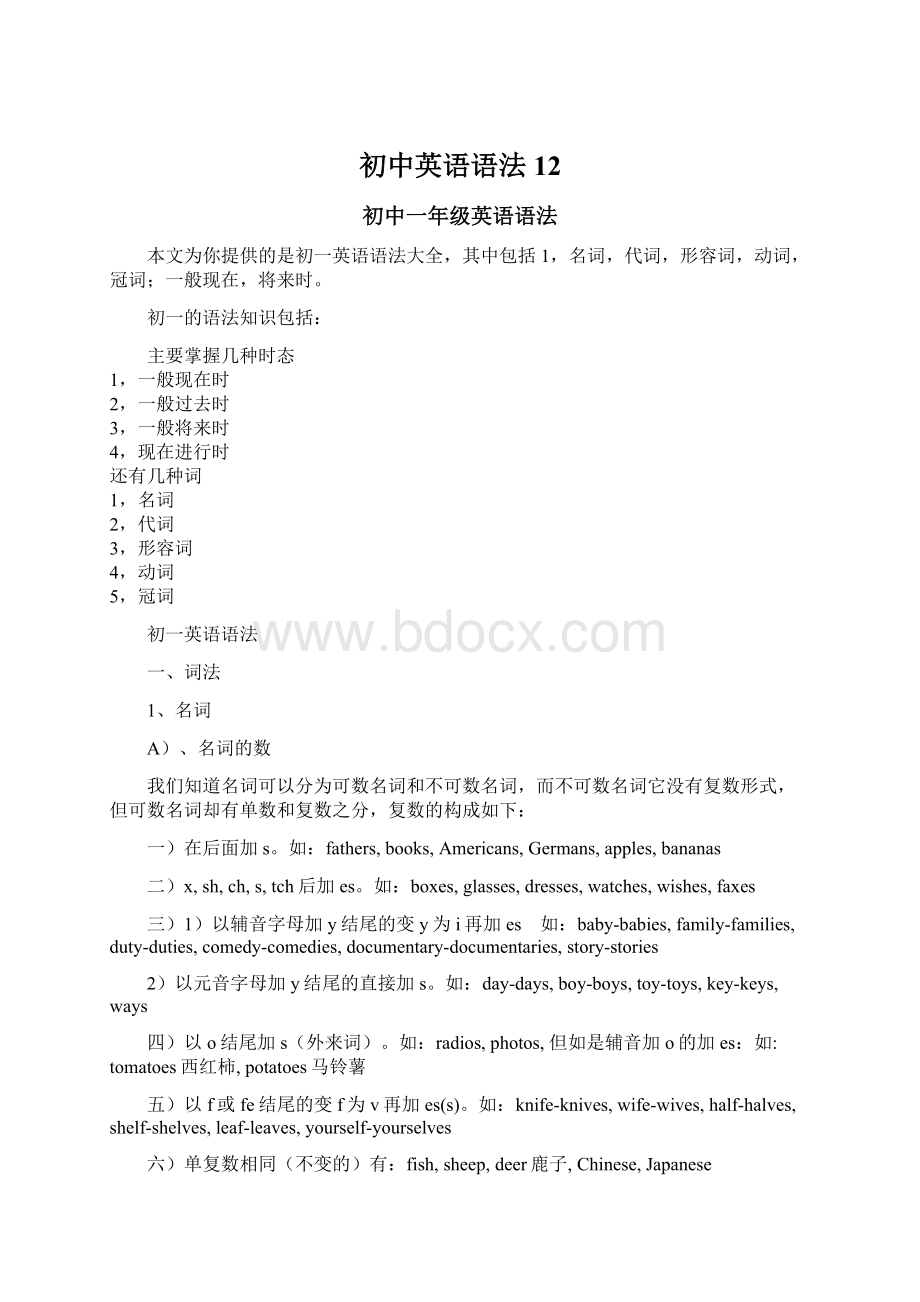初中英语语法12.docx
《初中英语语法12.docx》由会员分享,可在线阅读,更多相关《初中英语语法12.docx(14页珍藏版)》请在冰豆网上搜索。

初中英语语法12
初中一年级英语语法
本文为你提供的是初一英语语法大全,其中包括1,名词,代词,形容词,动词,冠词;一般现在,将来时。
初一的语法知识包括:
主要掌握几种时态
1,一般现在时
2,一般过去时
3,一般将来时
4,现在进行时
还有几种词
1,名词
2,代词
3,形容词
4,动词
5,冠词
初一英语语法
一、词法
1、名词
A)、名词的数
我们知道名词可以分为可数名词和不可数名词,而不可数名词它没有复数形式,但可数名词却有单数和复数之分,复数的构成如下:
一)在后面加s。
如:
fathers,books,Americans,Germans,apples,bananas
二)x,sh,ch,s,tch后加es。
如:
boxes,glasses,dresses,watches,wishes,faxes
三)1)以辅音字母加y结尾的变y为i再加es 如:
baby-babies,family-families,duty-duties,comedy-comedies,documentary-documentaries,story-stories
2)以元音字母加y结尾的直接加s。
如:
day-days,boy-boys,toy-toys,key-keys,ways
四)以o结尾加s(外来词)。
如:
radios,photos,但如是辅音加o的加es:
如:
tomatoes西红柿,potatoes马铃薯
五)以f或fe结尾的变f为v再加es(s)。
如:
knife-knives,wife-wives,half-halves,shelf-shelves,leaf-leaves,yourself-yourselves
六)单复数相同(不变的)有:
fish,sheep,deer鹿子,Chinese,Japanese
七)一般只有复数,没有单数的有:
people,pants,shorts,shoes,glasses,gloves,clothes,socks
八)单词形式不变,既可以是单数也可以是复数的有:
police警察局,警察,class班,同学,family家,家庭成员
九)合成的复数一般只加主要名词,多数为后一个单词。
如:
actionmovie-actionmovies,penpal-penpals;但如果是由man或woman所组成的合成词的复数则同时为复数。
如:
mandoctor-mendoctors,womanteacher-womenteachers
十)有的单复数意思不同。
如:
fish鱼fishes鱼的种类,paper纸papers报纸,卷子,论文,work工作works作品,工厂,glass玻璃glasses玻璃杯,眼镜, orange桔子水oranges橙子,light光线lights灯,people人peoples民族, time时间times时代,次数,chicken鸡肉 chickens小鸡
十一)单个字母的复数可以有两种形式直接加s或’s。
如:
Is(I’s),Ks(K’s)。
但如是缩略词则只加s。
如:
IDs,VCDs,SARs
十二)特殊形式的有:
child-children,man-men,woman-women,foot-feet,mouse-mice,policeman-policemen,Englishman-Englishmen
B)名词的格
当我们要表示某人的什么东西或人时,我们就要使用所有格形式。
构成如下:
一)单数在后面加’s。
如:
brother’s,Mike’s,teacher’s
二)复数以s结尾的直接在s后加’,如果不是以s结尾的与单数一样处理。
如:
Teachers’Day教师节,classmates’;Children’sDay六一节,Women’sDay三八节
三)由and并列的名词所有时,如果是共同所有同一人或物时,只加最后一个’s,但分别拥有时却分别按单数形式处理。
如:
MikeandBen’sroom迈克和本的房间(共住一间),Mike’sandBen’srooms迈克和本的房间(各自的房间)
2、代词
项目人称代词物主代词指示代词反身代词
人称主格宾格形容词名词性
第一人称单数Imemyminemyself
复数weusouroursourselves
第二人称单数youyouyouryoursyourself
复数youyouyouryoursyourselves
第三人称单数sheherherhersherself
hehimhishishimself
itititsitsthisthatitself
复数theythemtheirtheirsthesethosethemselves
3、动词
A)第三人称单数
当动词是第三人称单数时,动词应该像名词的单数变动词那样加s,如下:
一)一般在词后加s。
如:
comes,spells,waits,talks,sees,dances,trains
二)在x,sh,ch,s,tch后加es。
如:
watches,washes,wishes,finishes
三)1)以辅音字母加y结尾的变y为i再加es。
如:
study-studies,hurry-hurries,try-tries
2)以元音字母加y结尾的直接加s。
如:
plays,says,stays,enjoys,buys
四)以o结尾加es。
如:
does,goes
五)特殊的有:
are-is,have-has
B)现在分词
当我们说某人正在做什么事时,动词要使用分词形式,不能用原形,构成如下:
一)一般在后加ing。
如:
spell-spelling,sing-singing,see-seeing,train-training,play-playing,hurry-hurrying,watch-watching,go-going,do-doing
二)以不发音e的结尾的去掉e再加ing。
如:
dance-dancing,wake-waking,take-taking,practice-practicing,write-writing,have-having
三)以重读闭音节结尾且一个元音字母+一个辅音字母(注意除开字母组合如show–showing,draw-drawing)要双写最后的辅音字母再加ing。
如:
put-putting,run-running,get-getting,let-letting,begin-beginning
四)以ie结尾的变ie为y再加ing。
如:
tie-tying系 die-dying死 lie-lying位于
4、形容词的级
我们在对两个或以上的人或物进行对比时,则要使用比较或最高级形式。
构成如下:
一)一般在词后加er或est(如果是以e结尾则直接加r或st)。
如:
greater-greatest,shorter–shortest,taller–tallest,longer–longest,nicer-nicest,larger-largest
二)以重读闭音节结尾且1个元音字母+1个辅音字母(字母组合除外,如few-fewerfewest)结尾的双写结尾的辅音再加er/est。
如:
big-biggerbiggest,red-redderreddest,hot-hotterhottest
三)以辅音字母+y结尾的变y为i加er/est。
如:
happy-happierhappiest,sorry-sorriersorriest,friendly-friendlierfriendliest(morefriendlymostfriendly),busy-busierbusiest,easy-easiereasiest
四)特殊情况:
(两好多坏,一少老远)
good/well-betterbestmany/much-moremost bad/ill–worseworst
little-lessleastold-older/elderoldest/eldestfar-farther/furtherfarthest/furthest
5、数词(基变序,有规则;一、二、三,自己背;五、八、九、十二;其它后接th;y结尾,变为i,eth跟上去。
)first,second,third;fifth,eighth,ninth,twelfth;seventh,tenth,thirteenth,hundredth;twenty-twentieth,forty-fortieth,ninety-ninetieth
二、句式
1.陈述句
肯定陈述句a)Thisisabook.(be动词)
b)Helooksveryyoung.(连系动词)
c)Iwantasweatlikethis.(实义动词)
d)Icanbringsomethingstoschool.(情态动词)
e)There’sacomputeronmydesk.(Therebe结构)
否定陈述句a)Thesearen’ttheirbooks.b)Theydon’tlooknice.
c)Katedoesn’tgotoNo.4MiddleSchool.d)Katecan’tfindherdoll.
e)Thereisn’tacathere.(=There’snocathere.)
2.祈使句
肯定祈使句a)Pleasegoandasktheman.b)Let’slearnEnglish!
c)Comein,please.
否定祈使句a)Don’tbelate.b)Don’thurry.
3.疑问句
1)一般疑问句a)IsJimastudent?
b)CanIhelpyou?
c)Doesshelikesalad?
d)DotheywatchTV?
e)Isshereading?
肯定回答:
a)Yes,heis.b)Yes,youcan.c)Yes,shedoes.d)Yes,theydo.e)Yes,sheis.
否定回答:
a)No,heisn’t.b)No,youcan’t.c)No,shedoesn’t.d)No,theydon’t.e)No,sheisn’t.
2)选择疑问句Isthetablebigorsmall?
回答It’sbig./It’ssmall.
3)特殊疑问句
① 问年龄HowoldisLucy?
Sheistwelve.
② 问种类 Whatkindofmoviesdoyoulike?
Ilikeactionmoviesandcomedies.
③ 问身体状况Howisyouruncle?
Heiswell/fine.
④ 问方式Howdo/canyouspellit?
L-doubleO-K.
Howdowecontactyou?
Mye-mailaddressiscindyjones@.
⑤ 问原因 Whydoyouwanttojointheclub?
⑥ 问时间What’sthetime?
(=Whattimeisit?
)It’saquartertotena.m..
Whattimedoyouusuallygetup,Rick?
Atfiveo’clock.
Whendoyouwanttogo?
Let’sgoat7:
00.
⑦ 问地方Where’smybackpack?
It’sunderthetable.
⑧ 问颜色Whatcolorarethey?
Theyarelightblue.
What’syourfavouritecolor?
It’sblack.
⑨ 问人物Who’sthat?
It’smysister.
Whoistheboyinblue?
Mybrother.
Whoisn’tatschool?
PeterandEmma.
WhoareLisaandTimtalkingto?
⑩ 问东西What’sthis/that(inEnglish)?
It’sapencilcase.
Whatelsecanyouseeinthepicture?
Icanseesomebroccoli,strawberriesandhamburgers.
11问姓名What’syouraunt’sname?
HernameisHelen./She’sHelen.
What’syourfirstname?
Myfirstname’sBen.
What’syourfamilyname?
Myfamilyname’sSmith.
12问哪一个Whichdoyoulike?
Ilikeoneinthebox.
13问字母 Whatletterisit?
It’sbigD/smallf.
14问价格 Howmucharethesepants?
They’re15dollars.
15问电话号码What’syourphonenumber?
It’s576-8349.
16问谓语(动作)What’shedoing?
He’swatchingTV.
17问职业(身份)Whatdoyoudo?
I’mateacher.
What’syourfather?
He’sadoctor.
三、时态
1、一般现在时 表示普遍、经常性的或长期性的动作时使用一般现在时,它有:
Be动词:
She’saworker.Issheaworker?
Sheisn’taworker.
情态动词:
Icanplaythepiano.Canyouplaythepiano?
Ican’tplaythepiano.
行为动词:
Theywanttoeatsometomatoes.Dotheywanttoeatanytomatoes?
Theydon’twanttoeatanytomatoes.
Ginahasanicewatch.DoesGinahaveanicewatch?
Ginadoesn’thaveawatch.
2、现在进行时 表示动词在此时正在发生或进行就使用进行时态,结构为sbbev-ingsth+其它.
I’mplayingbaseball.Areyouplayingbaseball?
I’mnotplayingbaseball.
Nancyiswritingaletter.IsNancywritingaletter?
Nancyisn’twritingaletter.
They’relisteningtothepopmusic.Aretheylisteningthepopmusic?
Theyaren’tlisteningtothepopmusic.
初中二年级语法
动词时态的句子结构及关键词:
一般现在时:
句子结构:
肯定句主语+be(am,is,are)+其他
否定句主语+benot+其他
疑问句Be+主语+其他
或:
肯定句主语+动词原型+其他(第三人称单数作主语动词要加"s")
否定句主语+don't+动词原型+其他(第三人称单数作主语don't改为doesn't)
疑问句DO+主语+动词原型+其他(第三人称单数作主语do改为does)
关键词:
sometimes,often,usually,always,everyday,onSunday
afternoon,at10o'clockinthemorning,fivedaysaweek,threetimesamonth等.
注:
在时间状语从句,条件状语从句中,常用一般现在时表示将来时,这时一般从句用一般现在时,主句用将来时
现在进行时:
句子结构:
肯定句主语+be+动词的现在分词+其他
否定句主语+benot+动词的现在分词+其他
疑问句Be+主语+动词的现在分词+其他
关键词:
now,rightnow,atthemoment,It's+几点钟等的句子.或look,listen,keepquiet等提示语.
一般将来时:
句子结构:
肯定句主语+will+动词原型+其他
否定句主语+willnot+动词原型+其他
疑问句Will+主语+动词原型+其他
(will可改为begoingto,当主语是第一人称时will可用shall)
关键词:
tomorrow,tomorrowmorning,atseveno'clocktomorrowevening,nextyear,
atteno'clocknextSunday,thisyear,attheendofthisterm,fromnowon,intheyear2008,soon,inafewdays'time,inthefuture等.
一般过去时:
句子结构:
肯定句主语+be(was,were)+其他
否定句主语+benot+其他
疑问句Be+主语+其他
或:
肯定句主语+动词的过去式+其他
否定句主语+didnot+动词原型+其他
疑问句Did+主语+动词原型+其他
关键词:
yesterday,yesterdaymorning等,lastweek,lastyear,attheendoflastterm,
一段时间+ago如:
tenyearsago,fivehoursago,onJanuary1st,2004,inthe
1980s等.
Justnow,intheolddays,longago,amomentago等.
过去进行时:
句子结构:
肯定句主语+was/were+动词的现在分词+其他
否定句主语+was/werenot+动词的现在分词+其他
疑问句Was/Were+主语+动词的现在分词+其他
关键词:
具体时间+过去的时间壮语如:
atteno'clockyesterdaymorning,at
thistimelastSunday等.
现在完成时:
句子结构:
肯定句主语+have/has+动词的过去分词+其他(第三人称单数用has)
否定句主语+have/hasnot+动词的过去分词+其他
疑问句Have/Has+主语+动词的过去分词+其他
关键词:
already,yet,just,ever,never,sofar,for+一段时间,since+过去的
时间或过去时从句.或thisyearalone"今年以来",thesefiveyearsalone"这五年
以来",inthelasttenyears"在过去的十年中"等.
过去将来时:
句子结构:
肯定句主语+would+动词原型+其他
否定句主语+wouldnot+动词原型+其他
疑问句Would+主语+动词原型+其他
(would可改为was/weregoingto,主语第一人称时would可用should)
过去将来时主要用在宾语从句中.
过去完成时:
句子结构:
肯定句主语+had+动词的过去分词+其他
否定句主语+hadnot+动词的过去分词+其他
疑问句Had+主语+动词的过去分词+其他
关键词:
by+过去某一时间点如:
bylastyear,bytheendof+过去某一时间点如:
bytheendoflastyear,before+过去某一时间点,bythetime+从句,或宾语从句中最后,请记住:
It'snottheendoftheworld,trytolookonthebrightsideof
thing,I'msureitwillbeallright.
这不是世界末日,试着往事情好的方面看,我确认一切都会好起来.
英语动词有两种语态:
主动语态和被动语态。
初中阶段的被动语态有五种时态,我们可以从以下方面进行小结:
一、被动语态的时态及结构(以动词do为例)
结构:
主语+be+过去分词
时态:
1.一般现在时:
am(is,are)done.
2.带情态动词的被动语态:
must(can,may,should,need,would)bedone
3.一般过去时:
was(were)done
*4.一般将来时:
will(shall)bedone
*5.现在进行时:
am(is,are)beingdone
6.现在完成时:
have(has)beendone
二、从初中阶段所学五种基本句型谈变被动语态时应注意的问题。
1.主语+连系动词+表语(S+V+P)
此结构不可用被动语态。
(正)Theflowerssmellsweet.
(误)Theflowersaresmeltsweet.
2.主语+不及物动词(S+V)
此结构不可变被动语态。
(正)Anaccidenthappenedlastnight.
(误)Anaccidentwashappenedlastnight.
3.主语+及物动词+宾语(S+V+O)
(1)将主动语态的宾语变为被动语态的主语
Childrenoftensingthissong
Thissongisoftensungbychildren.
(2)将含有介词或副词的动词短语变为被动结构时,不可将介词或副词去掉。
Weshouldlistentothete